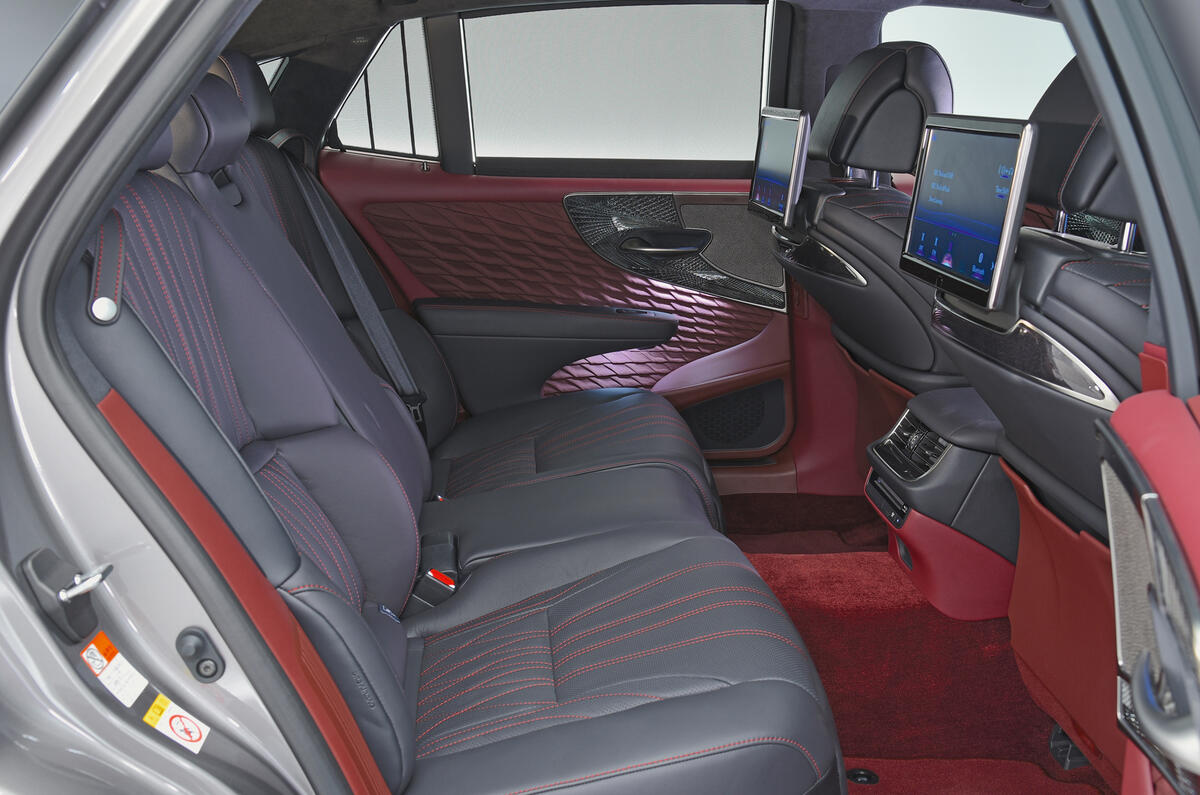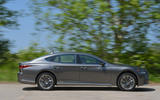It’s a classy car, the Lexus LS.
Not only is it equipped with smart hybrid technology and filled to the brim with gadgets and high-quality materials, but it’s also one of the smartest designs on the road.
Since the fifth-generation car’s launch in 2017, though, it has been tasked with an almost impossible mission: rivalling the practically flawless Mercedes-Benz S-Class and the more driver-focused BMW 7 Series.
But the LS does have one trick up its sleeve: exclusivity. Whereas S-Classes are a frequent sight, being beloved of ‘executive’ private hire firms everywhere, Lexus sold just 10 LSs here last year. If rarity is cool, this car is sub-zero.
One of the LS’s main draws is its hybrid power, and with almost 30 years of experience in building these sorts of drivetrains, Lexus can justifiably call itself an expert.
Every LS has a 3.5-litre V6 petrol engine, two electric motors and a lithium ion battery; your only choice is between rear- or four-wheel drive. Combined output stands at 354bhp, so it’s good for 0-62mph in a snappy 5.4sec.
There are a few negatives that we should point out, however. While the power is sufficient and effective at helping the LS overcome its 2.4-tonne kerb weight, the hybrid powertrain feels hesitant at times and struggles to respond to part-throttle inputs as effortlessly as you should expect of a luxury limo.
Still, the electric motor provides a decent slap of torque around town and fuel economy is reasonable, at an official average of 35.5mpg. We’ve also found it to be one of the better-handling cars in its class, while its interior is unique and nicely constructed, with plush materials including leather and real metals.
The LS initially offered four equipment grades: base, Luxury, F Sport and Premier. Even the base car was overflowing with technology and kit, but happily the majority of nearly new LS models have been specified in the range-topping trim.
A set of 20in alloy wheels and triple-LED headlights with automatic high beam are standard on entry-level cars, while inside there’s a 12.3in infotainment screen, digital dials, a 360deg camera, air-quality control, dual-zone climate control and heated leather seats.
Move up to Luxury for fourzone climate control, a premium 23-speaker sound system and 28-way adjustable seats with ventilation in both the front and back.
F Sport gains bespoke styling that includes a unique alloy wheel design, a front grille with an L-shaped mesh pattern, black brake callipers and black detailing on the bootlid, front bumper and side sills. You also get smooth leather seats, variable-ratio steering and dynamic rear steering – not that any of that puts it on a par with a 7 Series for driver engagement.
In contrast, Premier focuses on relaxation and comfort. It therefore gets you enhanced driver-aid equipment, such lane-keeping assistance, pre-collision assistance and active steering assistance. That’s in addition to massage seats in the front, while those in the back gain their own entertainment screen and an extendable footrest.
In contrast, Premier focuses on relaxation and comfort. It therefore gets you enhanced driver-aid equipment, such lane-keeping assistance, pre-collision assistance and active steering assistance. That’s in addition to massage seats in the front, while those in the back gain their own entertainment screen and an extendable footrest.
An update to the LS in 2020 added a revised infotainment system, the Lexus Teammate driver-aid package, adaptive variable suspension and a revamp of the hybrid powertrain to improve acceleration at lower revs.
At the same time, the specification hierarchy was simplified to base, F Sport and Takumi, while entry-level cars could be bolstered with an optional Premium Pack.
Equipment is largely the same across the board, although used prices haven’t yet sunk to quite the same levels as those for cars from before the change.
Need to know
Prices started at £72,595 in 2017 and rose to £97,995 for the AWD Premier. The cheapest fifth-gen LSs today cost from around £52,000, but most are in range-topping Premier trim.
Post-facelift cars are decidedly more expensive, starting closer to £70,000. Lexus is the ultimate brand for reliability, according to What Car?’s 2021 survey. It topped a list of 30 brands with an excellent score of 98.7%.
Lexus cars are often praised for their relaxing characteristics and refined cruising manners. In the LS’s 2018 road test, we measured 65dBA of ambient noise at 70mph. That’s certainly quieter than in most large cars but it is a shade noisier than both the rival BMW 7 Series and Mercedes-Benz S-Class that we’d tested a few years earlier.
Buyer beware
Cracking impeller: The LS was part of a recall that involved 6787 Lexus and Toyota cars in October 2020, because the fuel pump impeller could crack and stop working properly. Cars built from 11 October 2017 to 9 September 2019 were affected. The fix is free of charge, though.
Short on storage: The LS has 430 litres of boot space, which is disappointing for a 5.2m-long limo. The Mercedes-Benz S-Class has a much better, 510-litre boot, while the BMW 7 Series’ is larger still, at 515 litres.
Our to spec
Premier: Most cars on the used market are in range-topping Premier trim. It gives the highest level of comfort for drivers and passengers.
Our pick
LS 500H: There’s just one engine to choose: a hybridised 3.5-litre V6. It’s frugal, especially around town, and has a decent amount of power on tap.
Wild card
Mercedes-Benz S500LH :The plug-in hybrid S-Class has the potential for even greater economy. We found a 2017 example with 30,000 miles on the clock for £41,500.
Ones we found
2018 Lexus LS 500h AWD Luxury, 27,300 miles, £52,000
2018 Lexus LS 500h AWD Premier, 22,000 miles, £55,479
2021 Lexus LS 500h RWD F Sport, 10,300 miles, £77,920

























Join the debate
Add your comment
I have driven quite a long way in these, so i thought i would give a different view. I didnt detect any hesitancy in the powertrain, which is silky smooth, and more than powerful enough. The economy is pretty dreadful around town, but truely amazing on a long cruise (44mpg impressed me). Very comfortable (although you need to like firmish seats), and built like a tank. less rear leg room than you would expect from a 17 foot long car, and yes, quite a tiny boot, blame the batteries. I doubt there is a better built in Stereo, and you still get a CD player. The interior is amazing in design, materials used, and construction. A 10 year warranty is nice to know too, although i doubt any claims will be needed on it. At £50k they are amazing value